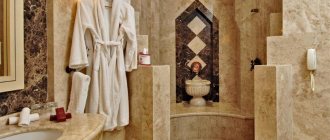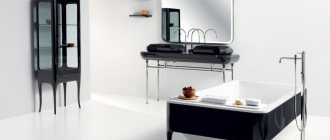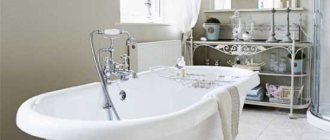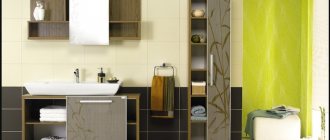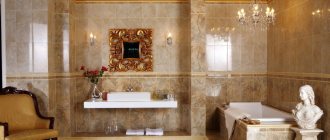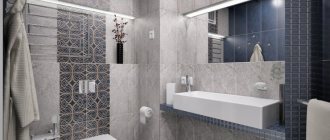Not only in a private house designed to order by the owner, but also in a typical apartment in a multi-storey building, you can decorate a bathroom in the laconic and restrained style of the Japanese Islands. Calmness, closeness to nature, laconicism - these characteristic style features have been developed over centuries of Japanese life and help restore strength, calm the nervous system and harmonize thoughts during bath procedures.
A Japanese-style bathroom is not just a series of design techniques, it is an understanding of the interior as part of your personality, a place of strength and peace
A Japanese-style bathroom is not just a series of design techniques, it is an understanding of the interior as part of your personality, a place of strength and peace.
Features of a Japanese bathroom
Japanese homes are characterized by a small area, which is due to the culture and history of the people. It was in Japan that minimalism originated, as in conditions of cramped people learned to make do with little. The bathroom was also furnished in a minimalist style. Instead of the familiar full-length bathtubs, they used wooden barrels or special wooden containers that were built into the floor.
We return here every evening, after a hard day of work, to absorb the fullness of the relaxing and rejuvenating effect.
Today, real wooden barrels are still part of the Japanese bathhouse, and bathtubs in the floor are often used in modern interiors.
This room can not only save you from the endless noise and bustle, but also give you a boost of energy for the whole day.
There is nothing superfluous in a Japanese bathroom. Here a person performs hygiene procedures while taking a break from the working day, and therefore nothing should distract him.
Exquisite Japanese style bathroom.
Most often, the room is covered with wooden or bamboo panels, but today you can use materials that imitate them, for example, laminate. The color scheme is in warm, natural tones, diluted with red and black.
The beauty and splendor of Japanese interior lies in its minimalism and simplicity.
Important! To create an authentic environment, use all shades of brown in your design, avoid color contrasts that make the design hectic, distracting, or colorful.
Results
Use a combination of matte and glossy surfaces in your bathroom and kitchen design. Turquoise in company with blue, light blue and green is one of the best solutions in interior design. These colors allow you to divide the space into work areas. Make the ceiling white or slightly noticeable blue.
In any case, it all depends on your imagination or design idea approved by you. For contrast, the floor can be made a darker and richer shade. Combinations of white with green, yellow and turquoise are suitable for wall decoration.
Japanese bathroom layout
The Japanese rarely see a combined bathroom in an apartment. The classic bathroom in Japan is separated from the toilet. When planning an oriental design in your own home, think of a way to separate two rooms, perhaps using a symbolic partition or screen. The separation of the bathroom is associated with the culture of hygiene that prevails in Japan. Here, taking a bath is an entire art that has been created over the course of a century.
Ergonomic design is able to harmoniously combine natural motifs and modern conveniences.
The specifics of the culture determine the layout of the room itself. A traditional Japanese-style bathroom features a shower and a deep, square bathtub made of wood that is built into the floor. This design allows you to retain heat for a long time. To minimize heat loss, half of the bath was covered with a lid.
Japanese style inspiration.
Modern rooms look different - they often have a shower stall and a countertop with a sink - an echo of ancient times, when a vessel with water was simply placed on the table.
If you have enough space, a bathroom can fit comfortably into the overall design of your home.
In small apartments you have to choose between a shower and a bathtub, and to reproduce the Japanese style, it is recommended to choose the second option.
Pay attention to the use of a ladder as a stylish and fashionable accessory for storing towels.
Bamboo tiles
Natural motifs never lose their relevance when it comes to wall cladding in bathrooms. It is the freshness and unobtrusive tones that you want to see in this room. For wall cladding in the toilet, the preferred design is Bamboo tiles in pastel, blue and green shades. The image of a plant on the material allows you to feel like a part of oriental nature.
Bamboo tiles for the bathroom are used to decorate the walls and floor, selecting a material with a general plant composition, or with single inclusions of a pattern.
If you want to create a single harmonious composition in the bathroom, you can even choose furniture with a picture of bamboo. Since ceramic tiles are an easy-to-maintain material, you just need to wipe them with a damp cloth, or, in case of water deposits, use special descaling agents, which can easily be purchased at any hardware store.
Japanese bathroom design
The main feature that distinguishes an eastern interior from a western one is minimalism, which here does not look cold and uninhabited, but, on the contrary, seems warm and cozy. The secret is not so much in the layout as in the choice of design materials. The Japanese use natural stone, wood, and bamboo to achieve a feeling of warmth and unity with nature.
An excellent choice would be to use natural wood in the design.
Design Features:
- laconic lines;
- predominance of geometric shapes;
- lack of pretentiousness and decorative elements;
- daylight;
- use of natural materials;
- warm colors.
If the main purpose of this room in your home is a place for relaxation and beauty treatments, then why not decorate it in the style of a SPA salon.
The key element in the room will be the Japanese bathtub, which differs from the European one not only in its location and shape, but also in its placement.
A glass shower cabin, wooden benches and a huge number of terry towels will be relevant.
When developing a drawing of a room, be sure to plan a podium into which a traditional bath will be built. Without this element, the design is unlikely to be authentic, and therefore a small podium should be provided, which is usually placed in the back of the room.
Japanese-style room with an oval pebbled bathtub and black granite
For wall coverings, use natural wood panels, brown tiles, stone or laminate. Combinations of brown and white, as well as their combinations with black, look organic. All three colors can be used harmoniously within the design of one room. Black tiles are ideal for floors, wood siding for walls, and white for plumbing fixtures.
To achieve results, it is enough to adhere to several general trends.
It is better to choose wall-mounted furniture and plumbing fixtures - such models look modern and are suitable for Japanese design. A sink on a wooden countertop, a hanging cabinet and a bathtub built into the floor - there is nothing superfluous in Japanese design.
Ultra-minimalism in the Japanese style is truly amazing.
In a large room, you can use a screen to zone the space. In a small one, it is advisable to do without even a shower curtain, which will look too European.
Just take a look, it looks just great!
Accessories and decor are also recommended to be used in a large room, as they can overload a small room.
There is no need to try to dilute the design with bright decor; give preference to calm tones when it comes to the bathroom.
Note! If it is not possible to organize a real Japanese bath, then purchase a model that closely resembles a traditional ofuro.
Space planning
Important! It is not in Japanese tradition to combine a bathroom and a bath in one room.
If all the plumbing is concentrated in one area, it is necessary to visually differentiate the toilet and bathtub using screen partitions, plasterboard structures stylized for them, or open shelves.
Usually the bathtub is placed in the center of the room, but if there is a window, then the bathtub should be located directly next to it
Shoji partitions move horizontally and are most often decorated with wooden lathing. Such screens easily contribute to the creation of style, but in a small area they are inappropriate.
Usually the bathtub is placed in the center of the room, but if there is a window, then the bathtub should be located directly next to it.
Stylish zoning of the bathroom space is helped by podiums on which you can place a shower compartment, bathtub or sink
When creating a Japanese interior, many designers create rectangular niches in which you can place a mirror or hanger, shelves for towels or a washing machine. Functional niches help to gain additional space and compactly place the necessary things.
Stylish zoning of the bathroom space is helped by podiums on which you can place a shower compartment, bathtub or sink.
Types of Japanese baths
Today there are two main types of baths in Japan: furako and ofuro. They differ in shape and purpose. A separate item includes a traditional wooden bath, which is essentially a type of ofuro.
As you know, the main rule of Japanese design is strict minimalism.
Furaco
Many people know that in Japan, bathtubs were made of wood. This tradition appeared in ancient times and is still relevant today. The bathtub can be round, square, rectangular or oval.
If the bathroom is large enough, a traditional Japanese bathtub would be an excellent solution.
Furaco is a large barrel in which it is customary to bathe in hot water. Furaco in its original form is used in baths and fonts. It can be installed in private houses, cottages, and dachas. Furaco is unlikely to look organic in an apartment due to its size and water heating features.
As an option, you can use cedar - similar properties are complemented by a wonderful aroma.
Ofuro
Today, the term ofuro is used to describe any bathtub in the Japanese or similar style. Initially, ofuro meant a wooden bathtub built into the floor, into which one immersed oneself up to the shoulders. Today, ofuro is made not only from wood, but also from other materials, including modern, technological ones. The only feature that has survived to this day is that the bathtub has a square shape, less often rectangular, unlike furaco, which is made in a round or oval shape.
Ofuro is a wooden Japanese bathtub made from hinoki wood.
Today you can easily find a suitable ofuro model to install in an apartment or private house. This term refers to any round, streamlined high bathtub or low, square bathtub that is installed on a podium.
Any of the constituent design elements matters when creating a composition.
Wooden
Originally, the Japanese wooden bathtub was made from hinoki wood, which is characterized by antibacterial properties, resistance to mold and rot, and is also insect-resistant.
In the Japanese style, to achieve harmony, various calm tones are used, which please the eye and create balance.
Due to these properties, hinoki were used to make fonts. Some manufacturers produce wooden bathtubs that fit perfectly into the Japanese style of an apartment or house.
Important! A wooden bathtub will not only decorate your interior, but will help improve your health and calm your nervous system.
A Japanese-style bathroom should have simple lines and shapes and a neutral color scheme.
Advantages
The design of a space decorated with bamboo is elegant due to the excellent technical characteristics of the product. The main ones are:
- high moisture and heat resistance;
- soundproofing;
- versatility.
The wide distribution of bamboo in the interior provides a variety of texture options. The material is pliable and has a wide color palette. This quality allows you to realize the richest artistic ideas.
It is convenient to decorate any parts of the apartment with bamboo Source i2.wp.com
With bamboo cladding you can:
- expand visually the space;
- place accents;
- give the room rhythm.
Bathtub placement tips
In a traditional Japanese interior, the bathtub is a key component of the decor, and therefore it is placed in the most visible place. There are several placement methods:
- at the far wall on the podium;
- in the middle of the room (suitable for large rooms);
- in the corner (opposite you can install a shower);
- near the window.
Modern apartments, as a rule, have small bathrooms, but if you have the desire and imagination, it will not be difficult to decorate the room beautifully and stylishly.
The podium can also be installed in the center, which will also look stylish and in the spirit of Japan.
Japanese style is characterized by harmony and naturalness of shapes and lines. It encourages relaxation and relaxation. In a bathroom designed in an oriental style, you can truly enjoy peace and relaxation.
Original solution
There are plenty of traditional options for using ordinary bamboo in the interior. But there are rare design techniques. By combining panels, they create true works of art that decorate any room.
It is very convenient to use bamboo in the interior to disguise the flaws of the room. Stem cut in half:
- used as a plinth that will cover the joint between the parquet and the wall;
- disguises wiring and utilities.
Bamboo accessories are an excellent decoration for any interior. Their variety helps fill the space of the room with comfort and originality. Frames for mirrors, family photographs, and paintings are made from this material. It is enough to use a sawn trunk, connecting the cut parts together with extremely thin threads of jute. You can also purchase ready-made products. The following will help you create a unique picture:
- original lampshades for decorating lamps;
- plant pots for flower pots;
- cookware;
- all kinds of baskets;
- carpets and mats;
- decorative napkins;
- ashtrays;
- boxes for candy.
Bathroom decoration Source journal.homemania.ru
Hallway with bamboo trim Source journal.homemania.ru
Veranda with bamboo furniture Source journal.homemania.ru
Kitchen with bamboo blinds Source journal.homemania.ru
Living room in eco-style Source homeli.ru
See also: Catalog of companies that specialize in garden furniture.
Bedroom with characteristic headboard decoration Source journal.homemania.ru
Eco-style bedroom with luxury bamboo furniture Source journal.homemania.ru
Country style kitchen Source journal.homemania.ru
Bathroom in olive and bamboo tones Source journal.homemania.ru
Bamboo accessories and furniture in the bathroom Source journal.homemania.ru
Hallway made of bamboo Source journal.homemania.ru
Sento
Unlike the two previous words, this is no longer a separate device, but the name of a Japanese public bathhouse. It has a pool with water whose temperature reaches 50 - 55 degrees. Before swimming, you usually take a contrast shower. Afterwards, visitors go to comfortable lounges and participate in a tea ceremony. Modern Japanese baths can offer additional services, which include massage, cosmetic masks, and therapeutic wraps. Each client will be able to choose a program strictly according to their preferences.
Despite all the differences in names in the arrangement, the key principles remain strictly unchanged. Unlike a sauna, healing and cleansing is achieved without exposure to significant temperature or high humidity. Use warm water, sawdust and pebbles. The boxes into which visitors to the Japanese bath are immersed have thick metal walls and must be equipped with means of electrical heating. The Japanese bathhouse is similar to the Finnish, Russian, and Turkish only in the use of wood heating. Everything else is different. The difference is due to different philosophies and traditional cultural norms. Buddhism has a negative attitude towards the killing of animals, which in the Middle Ages was the only way to make soap (there were no other technologies). Therefore, the Japanese took the path of using the hottest water possible, which can be used without soap, then the need for cosmetic and hygiene products will disappear.
Furako and ofuro have become very popular for other reasons (due to the abundance of thermal springs characteristic of Japan). This circumstance made it possible to build many baths that consumed natural hot water and spent almost no fuel.
It should be noted that even in such a small island country there is internal cultural differentiation, in certain regions the names "furako" and "ofuro" refer to a bathtub and a barrel, respectively. But the approach does not change: you can use a container with sawdust only after bathing. To improve the result, natural components of plant or mineral origin are added to the water. Even experienced steamers with good health should not stay in furaco and ofuro for more than 15 minutes; for beginners or people with weakened bodies, this time is three times less.
While sitting in a barrel, you must avoid immersing your heart in water. If even the slightest discomfort occurs, you need to leave the container immediately, without counting on adapting after a few minutes. It will be good if a visitor to a Japanese bath takes a shower before diving.
The benefits will be as follows:
- improving blood circulation and kidney function;
- strengthening protection from physical and mental stress;
- assistance in losing weight;
- normalization of skin function.
All this will be achieved only under one condition - the correct use of bath procedures and the elimination of typical mistakes. Usually in Japanese public baths there is a special employee who explains what and how exactly to do. In addition to showering, before starting to wash, it is advisable to steam your feet and get a massage. The first barrel into which they are dipped is filled with water at a maximum temperature of 45 degrees. Then they move to the second container, where the liquid is heated to 45 - 50 degrees.
In order to save space and water, commercial establishments and private homes usually use only one barrel, varying the heating of the water in it using specialized equipment.
After bathing, be sure to wipe yourself dry and go into a bath with cedar or aspen sawdust. This part of the bath procedure allows you to relax and sweat, in addition to receiving a solid portion of biologically active substances contained in wood. Additionally, medicinal herbs and essential oils are used. The dry part of the bath is very hot, it warms up to 60 degrees. It is strictly unacceptable for children under three years of age, as well as pregnant women, to go to a Japanese bathhouse. The ban applies to everyone who has heart and vascular disorders. This is unacceptable for patients with tuberculosis or any other acute infections.
Recommendations
Since furaco is a rather complex design, and it is difficult for non-professionals to prepare it, it is better to order an individual project or buy a ready-made sample. To make it, you should use boards from trees that have grown for at least 200 years. After completion of the work, the surface of the barrel must be coated with wax (this will increase its service life). Metal structures cannot be used for connection. Be sure to make a couple of wooden stairs so that you can enter and exit the furaco autonomously, without interfering with each other.
If the barrel is placed on top of the stove, it is recommended to place a reliable thermometer inside: then it will be easier to control the water temperature. When choosing a design with an internal oven location, a vertical partition is used, thanks to which users will not be at risk of burns. The oven must be completely immersed in water: you need to take only structures that close hermetically. Furaco, heated by external stoves through a heating water supply, is the most modern and safe solution.
In the latter case, you will need to provide an additional pipe to drain the cooled liquid (the tap at the bottom helps drain the container). Wood heating is preferable for outdoor baths; an electrical system is more often used inside the building. Compliance with truly Japanese traditions implies a large size of the rest room.
Buddhist slowness and tranquility require the use of large tables, chairs and comfortable sofas, and the allocation of a place where you can make tea. A sanitary facility in a Japanese bath is strictly required. For the top waterproofing of foundation pillars, it is recommended to use liquid bitumen, covered with two layers of roofing material. When decorating interior spaces, you should not use pine and spruce: these species easily heat up (the risk of burns is high). Any wood should be treated with antiseptic compounds. A ventilation system is always installed, thanks to which the room will dry faster.
A Japanese-style sawdust bath is filled with sawdust, heated to 50 degrees. Traditionally, cedar sawdust mixed with rice bran and crushed medicinal plants is considered to have the most valuable medicinal properties. You should not think that using a Japanese bath in a city apartment is an unattainable dream.
Its imitation is achieved through special techniques:
- water heated to exactly 37 degrees is poured into the bath;
- within 12 - 15 minutes of bathing, you need to gradually raise the temperature to 41 - 43 degrees;
- warmed-up visitors come out and put on terry robes;
- sweating takes approximately 1⁄2 hours;
- a suitable drink is tea with raspberries or honey;
- The procedure ends with air drying and two hours in bed under blankets.
For a review of the Japanese bath, watch the following video.


